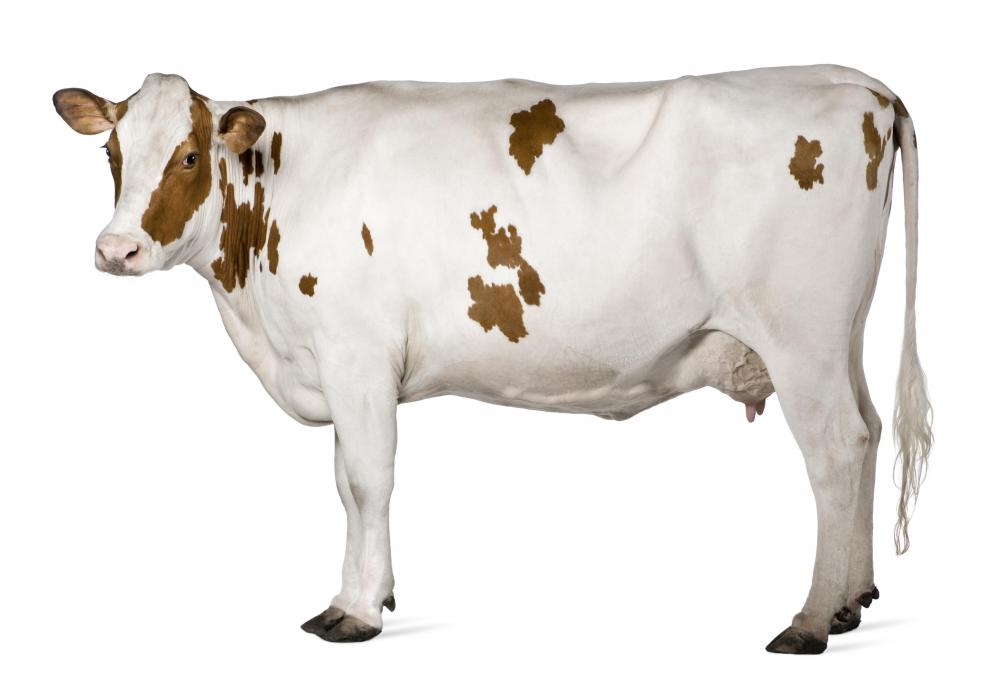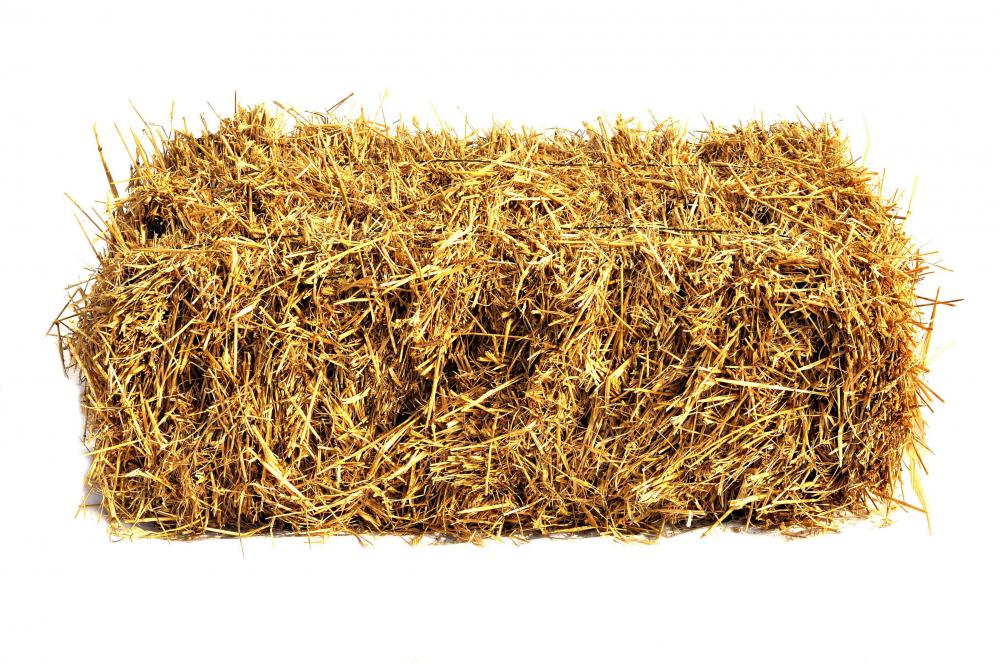At AllThingsNature, we're committed to delivering accurate, trustworthy information. Our expert-authored content is rigorously fact-checked and sourced from credible authorities. Discover how we uphold the highest standards in providing you with reliable knowledge.
What is a Cow?
The word cow is a generic term for domesticated bovines, which people often raise for meat, milk, leather products and draft work. There are an estimated 1.3 billion in the world, most of which are raised for agricultural purposes, and over time, the animals have gained multiple spiritual and symbolic associations. Despite being relatively placid, plant-eating creatures that have been raised for thousands of years, they are controversial, because raising them frequently levies heavy costs in terms of pollution and environmental damage. Many individuals also have concerns related to ethical treatment and the diseases they carry.
Differentiations

Properly, the word cow refers only to female adult bovines, but people use it to talk about all cattle in a very general sense. In correct terminology, an uncastrated adult male bovine is a bull, a castrated male is a steer, and a juvenile of either sex is a calf. Before they have their first calf, females are also referred to as heifers.
Physical Characteristics

All the different subspecies of cow share important anatomical characteristics. Most basically, they are four-legged, hoofed animals, having long tails that they use to brush away pesky insects. Their ears have a wide range of rotation, which makes it easy for them to pick up on different sounds in the environment and stay safe. These creatures are also ruminants, meaning that they can regurgitate and re-consume indigestible foods, breaking them down further in one of their four stomachs. When properly using the term for adult females, two other major physical traits are the udders and teats located on the animals' underbellies in front of the hind legs, which provide milk for calves or people, and which can be quite large when full.
Diet

These animals are natural vegetarians, and they feed primarily on grasses and grains. Farmers often allow them to graze in fields when their numbers are relatively limited, but in very large operations, it is more common for them to be fed hay, which is simply grasses that have been cut and dried. Cows also eat large amounts of silage, which is whole grain and corn plants that have been chopped and allowed to ferment, and shelled grain corn, which is frequently mixed with other foods, such as soybeans.
Uses

People traditionally have used cows both for meat and their milk. Science and technology has allowed dairy farmers to breed ones that have a much higher rate of lactation, however, so today, most agricultural productions concentrate on one area or the other. A typical dairy cow makes up to 7 gallons (26.5 liters) every day, and many farms have a hundred animals or more. In the United States alone, they produce 23 billion gallons (87.1 billion liters) of milk every year, and roughly 34 million head of cattle are slaughtered annually.

Another main use is leather, which is skin that has been cleaned, cured and chemically treated to make it durable and prevent it from quickly decaying. It is frequently used in the fashion industry to make clothes, shoes and accessories, such as purses. The furniture industry also uses bovine leather to a large degree.
In many areas of the world, bovines are the primary draft animals instead of horses, with people using them to pull everyday loads. This includes moving items such as plows, so they often are important to communities in terms of being able to produce a crop. The ability to move goods on carts connected to cattle also influences the ability to trade and build.
Concerns

Cattle are often raised in enormous herds, as they make up a huge portion of the world’s agricultural industry. This can cause a severely negative impact on the local environment, which can quickly become overstressed by too many grazing animals. Stream and river pollution around cattle ranches is often severe, and many studies show that local ecosystems can be devastated by a large cattle operation. Many experts suggest that the single best thing people can do for the environment is to give up all cattle products.
With the vastness of the meat, dairy and leather industries, the humane treatment of cattle has become a controversial issue, as well. Videos and stories of severe physical abuse are prevalent among animal rights groups and frequently have good supporting evidence. Many environmental and animal experts believe that inhumane treatment of these animals is both unwarranted and uncivilized, and despite the widespread use of cows for food, it is not unusual for people to refuse to eat beef products because of the way some farmers are raising and slaughtering their livestock.
Toward the end of the 20th century, experiments with feeding cattle scrap beef products led to the rise of bovine spongiform encephalopathy (BSE), more commonly known as mad cow disease. This condition is a fatal disorder that causes the brain and spinal tissue to degenerate, and is thought to be caused by prions, or misfolded proteins. Some research suggests that the root of the disease is genetic. In addition to killing thousands of bovines around the world, the disease also has caused fatalities in people, leading to many import bans and widespread contamination efforts.
Brief History of Domestication
Cows are considered some of the earliest known domesticated animals. Evidence suggests that humans have been keeping them as livestock since the Neolithic period, around 10,000 BCE. Some cultures developed highly elaborate customs regarding cattle and their agricultural uses.
Symbolism and Associations
Symbolically, cows are typically images of strength and resolve. In Greek astrology, they represent the zodiac sign and constellation Taurus, which is associated with both stubborn behavior and power. The ox also appears in the Chinese zodiac, and an ox personality is said to be patient, calm and determined. In Hinduism, they are not slaughtered for meat, as they are considered sacred providers for their milk. Strict observers of Hindu customs will not eat beef or beef products.
Frequently Asked Questions
What exactly is a cow?
A cow is a domesticated mammal from the species Bos taurus, commonly raised for its meat (beef), milk, and hides. Cows are ruminants, meaning they have a specialized stomach system that allows them to digest tough plant material. They play a significant role in agriculture and have been part of human society for thousands of years.
How many breeds of cows are there?
There are over 800 breeds of cows worldwide, each adapted to local environments and developed for different purposes, such as dairy production, meat, or work. The Holstein-Friesian, known for its high milk yield, is one of the most recognized dairy breeds, while the Angus is famed for its beef quality.
What is the lifespan of a cow?
The average lifespan of a cow is about 20 years, but this can vary depending on whether the cow is raised for dairy or beef. Dairy cows typically live between 5 to 8 years in production, while beef cattle may live up to 12-15 years if not slaughtered for meat at a younger age.
How much milk can a cow produce?
A dairy cow's milk production varies by breed, age, diet, and management, but on average, a cow can produce 6 to 7 gallons of milk per day. According to the American Dairy Association, the average dairy cow in the U.S. produces more than 2,300 gallons of milk annually.
What is the environmental impact of raising cows?
Raising cows has a significant environmental impact, including greenhouse gas emissions, water usage, and land degradation. Livestock is responsible for about 14.5% of global greenhouse gas emissions, with cattle contributing a major portion, mainly due to methane production from enteric fermentation, according to the Food and Agriculture Organization of the United Nations.
Are cows intelligent animals?
Cows are intelligent animals with the ability to solve problems, remember tasks, and recognize individuals within their herd. They have a complex social structure and can form strong bonds with other cows and even humans. Studies have shown that cows can experience a range of emotions, indicating a level of cognitive complexity.
AS FEATURED ON:
AS FEATURED ON:
















Discussion Comments
I don't agree with the statements that large cattle ranches are harmful to the environment because they "can cause a severely negative impact on the local environment, which quickly becomes over-stressed by too many grazing animals." This is old news and something that ranchers have long learned from that devastating winter in 1885-86 where thousands of cattle died from malnutrition due to lack of adequate grazing and winter feed.
If a large rancher does as what the article states, there's not going to be much grazing left for cattle to regraze during the next time they come to graze or even the next grazing period. You stress the grass too much you kill off your range or pasture. Yes, some ranches may be guilty of this, but not all.
"Stream and river pollution around cattle ranches is often severe..." Some, but not all. There are many large cattle ranches that are adopting much more sustainable methods of raising cattle, which include getting cattle away from the streams, the riparian and wetland habitats by use of fences, and watering them away from such areas.
Animal cruelty is just really wrong! These animals are here for a reason. They provide us with food for survival and health. They should be treated with kindness and respect. People should follow the proper procedures in slaughtering cows for meat and other things.
I don't know whether or not I agree with the author's paraphrased statement that all cattle products should be avoided. Cattle do provide us with, often times, inexpensive food and products. I would much rather we educate ourselves, and demand better livestock raising practices.
Check out Temple Grandin. Her research and work on cattle/livestock behavior, raising and slaughter are absolutely amazing. We ought to support people like Dr. Grandin who offer a much more sensible line on livestock raising/slaughtering practice, rather than the inflexible and often unreasonable demands those who would rather ban any and all products made from animals.
Cows like to be treated kindly. It has been a known fact that a cow will produce more milk if she is relaxed, treated well and talked to with affection. Farmers know that fact, and even give names to their cows.
Post your comments